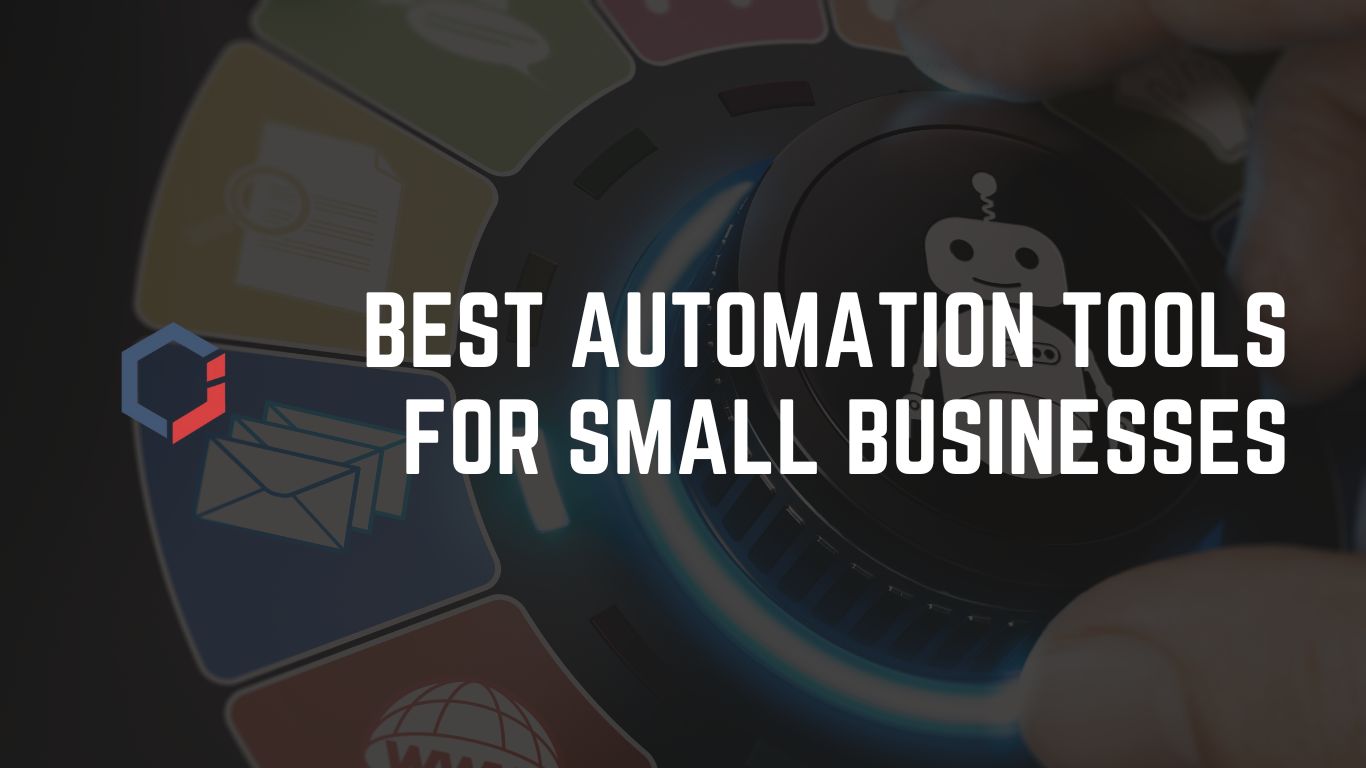Are you a small business owner feeling swamped? Too many repetitive tasks can eat up your time and drain your energy. Automation is a powerful solution that can help you save time, reduce errors, and boost productivity. By automating routine tasks, you free up valuable resources to focus on strategic growth and better serve your customers. As automation tools become increasingly essential, this guide covers some of the best automation tools across different business areas to help streamline operations, enhance efficiency, and support your business growth.
Table of Contents
- Customer Relationship Management (CRM) Automation
- Email Marketing Automation
- Sales Automation
- Customer Service Automation
- Social Media Automation
- Financial Automation
- Task and Project Management Automation
- Conclusion
Customer Relationship Management (CRM) Automation
CRM automation is crucial for improving your sales, marketing, and customer service efforts. It helps manage customer relationships more effectively, ensuring that leads are nurtured, customer queries are answered quickly, and your business stays organized. Implementing CRM automation can significantly impact your business operations, making your team more efficient and your customer interactions more personalized.
Key Benefits of CRM Automation:
- Streamlined Sales Process: CRM automation tools can handle routine tasks like follow-up emails, appointment scheduling, and data entry. This allows your sales team to focus on building relationships and closing deals instead of getting bogged down by administrative tasks.
- Better Customer Segmentation: Effective CRM systems help categorize your customers based on behavior, purchase history, and preferences. This allows you to tailor your marketing campaigns and sales outreach to specific segments, improving your chances of engagement and conversion.
- Enhanced Customer Retention: With automated follow-ups and timely reminders, CRM tools help ensure that customers are never forgotten. Maintaining regular communication with customers through automated systems can increase customer satisfaction and loyalty, ultimately improving retention rates.
Examples of CRM Automation Tools:
- HubSpot CRM: HubSpot offers a free tier that includes key automation features, such as email tracking, workflow automation, and lead nurturing. It’s a great option for small businesses looking to scale without a large upfront investment.
- Salesforce: As a leader in the CRM space, Salesforce offers comprehensive automation features to manage leads, opportunities, and customer service workflows, all in one platform.
Actionable Tip: Invest time in segmenting your CRM database. Automate follow-up emails tailored to each customer segment for better engagement and conversion. This targeted approach can significantly improve your marketing ROI.
For more details on how CRM tools can help small businesses scale, check out our article on how small businesses can scale effectively.
Email Marketing Automation
Email marketing remains one of the most effective ways to nurture leads and engage with your audience. Automation in email marketing allows you to communicate with your customers at scale, sending personalized messages based on their behaviors and interests. This means you can reach out to the right person, at the right time, with the right content, all while saving time and increasing conversions.
Key Benefits of Email Marketing Automation:
- Automated Sequences: Setting up email sequences allows you to guide leads through the sales funnel automatically. For example, a new subscriber might receive a welcome email, followed by educational content, product recommendations, and ultimately, an offer or call to action.
- Personalization at Scale: Automation tools allow you to personalize emails based on various data points, such as the recipient’s name, recent purchases, or browsing history. Personalized emails lead to higher engagement rates and improve the customer experience.
- Segmentation for Relevant Messaging: Effective email marketing tools allow you to segment your audience into categories, ensuring that your messages are relevant and timely. For example, you can send different messages to leads, new customers, and loyal customers based on their past behavior or purchase history.
Examples of Email Marketing Tools:
- Mailchimp: Known for its user-friendly interface, Mailchimp offers powerful email automation features, including segmentation, A/B testing, and detailed analytics. It’s particularly useful for small businesses and startups.
- Constant Contact: A great tool for beginners, Constant Contact provides easy-to-use email templates and automation features such as email scheduling and automatic reminders for abandoned carts.
Actionable Tip: Start by segmenting your email list based on factors like demographics, engagement, and purchase history. This will help you send more targeted messages that resonate with your audience, ultimately leading to higher conversion rates.
Want more tips on how to grow your email marketing strategy? Check out our guide on marketing strategies that actually work.
Sales Automation
Sales automation is designed to simplify and accelerate the sales process, allowing your team to focus on closing deals instead of handling manual tasks. By automating lead generation, nurturing, and follow-ups, you can ensure that your sales pipeline is always full and that your sales team can concentrate on the highest-priority leads.
Key Benefits of Sales Automation:
- Lead Nurturing: Sales automation tools allow you to send timely follow-ups to prospects who have shown interest in your products or services. For example, you might set up an automated email series for leads who download an eBook, guiding them toward a purchase decision.
- Lead Scoring: Many sales automation tools come with built-in lead scoring features. This means you can prioritize leads based on their likelihood to convert. Leads who engage with your content or visit your website multiple times are considered higher value and should be contacted first.
- Seamless Appointment Scheduling: Sales automation tools can integrate with your calendar, making it easy for prospects to schedule meetings or calls without the back-and-forth of finding available times.
Examples of Sales Automation Tools:
- HubSpot Sales Hub: HubSpot’s Sales Hub offers an all-in-one solution for automating lead tracking, sales workflows, and follow-up emails. It’s ideal for small businesses looking to streamline their sales process.
- Pipedrive: Pipedrive is a sales-focused CRM tool that helps automate lead tracking, sales pipeline management, and communication, providing valuable insights into your sales team’s performance.
Actionable Tip: Implement lead scoring to prioritize leads based on their likelihood to convert. This ensures your team spends more time nurturing high-potential leads and avoids wasting resources on less promising prospects.
Learn more about scaling your sales efforts with our article on how small businesses can win against the giants.
Customer Service Automation
In today’s fast-paced world, customers expect quick, reliable service. Customer service automation can help meet these expectations by providing faster responses, improving issue resolution times, and ensuring your support team spends less time on repetitive tasks.
Key Benefits of Customer Service Automation:
- Instant Responses: Chatbots and automated systems can instantly respond to frequently asked questions or direct customers to the appropriate resources, reducing wait times and improving customer satisfaction.
- Ticket Routing and Prioritization: Customer service tools can automatically route tickets to the correct team or department, ensuring that issues are resolved by the right experts. Additionally, automation can prioritize tickets based on urgency, so critical issues are handled first.
- Self-Service Support: Knowledge bases, FAQs, and AI-powered systems allow customers to find solutions to common problems themselves, reducing the need for live support and empowering customers to resolve issues quickly.
Examples of Customer Service Automation Tools:
- Zendesk: Zendesk offers a comprehensive customer service automation platform with ticket management, live chat, and automated responses to frequently asked questions.
- Freshdesk: This tool provides robust support automation, including ticket routing, SLA management, and AI-powered chatbots.
Actionable Tip: Set up chatbots to handle frequently asked questions and common support issues. This frees up your customer support team to focus on more complex inquiries.
For more insights on improving customer service, check out our article on common mistakes that can break your small business.

Social Media Automation
Managing social media can be overwhelming, especially when you’re trying to maintain a consistent presence across multiple platforms. Social media automation tools help you schedule posts, monitor brand mentions, and analyze your performance—without having to spend all day online.
Key Benefits of Social Media Automation:
- Scheduled Posts: Social media automation tools allow you to plan and schedule posts in advance, ensuring your brand remains active on platforms like Facebook, Instagram, Twitter, and LinkedIn without constant manual effort.
- Performance Analytics: These tools track engagement, clicks, shares, and more, providing valuable insights into what’s working and what’s not. This helps you refine your social media strategy over time.
- Social Listening: Social media monitoring tools help you track mentions of your brand, products, or industry. This allows you to respond quickly to customer inquiries, address complaints, or engage with positive feedback.
Examples of Social Media Automation Tools:
- Buffer: Buffer allows you to schedule posts, track social media analytics, and engage with your audience all from one platform. It’s especially useful for small businesses managing multiple social accounts.
- Hootsuite: Hootsuite is a comprehensive tool that allows you to schedule posts, monitor social media mentions, and analyze performance, helping you stay ahead of trends and optimize your content strategy.
Actionable Tip: Use analytics to identify the best times to post on social media. Scheduling posts during peak engagement hours can increase visibility and help you reach more of your audience.
Financial Automation
Managing your business’s finances efficiently is crucial for long-term success. Financial automation tools can help streamline bookkeeping, invoicing, and payments, making it easier to stay on top of your financial obligations and avoid errors.
Key Benefits of Financial Automation:
- Automated Bookkeeping: With automated bookkeeping tools, you can easily track income and expenses, generate financial reports, and stay compliant with tax regulations. Automation ensures accuracy and reduces the risk of human error.
- Recurring Invoices and Payment Reminders: Set up recurring invoices for regular customers, and automate reminders for overdue payments. This ensures consistent cash flow and reduces the likelihood of missed payments.
- Expense Tracking: Many financial automation tools allow you to track business expenses in real-time, providing you with detailed insights into your spending habits and helping you identify areas where you can save.
Examples of Financial Automation Tools:
- QuickBooks Online: A popular choice for small businesses, QuickBooks offers automated bookkeeping, tax reporting, and invoicing features to keep your financials in order.
- Xero: Xero is another powerful accounting tool that simplifies financial management, with features for invoicing, expense tracking, and bank reconciliation.
Actionable Tip: Automate your recurring expenses and invoices to save time. You can also set up automatic payment reminders to improve cash flow and reduce late payments.
Task and Project Management Automation
Task and project management tools are essential for ensuring that your team stays organized and on schedule. Automation features in project management tools help teams collaborate more effectively, track progress, and meet deadlines with minimal manual effort.
Key Benefits of Task and Project Management Automation:
- Task Assignment and Tracking: Automatically assign tasks to team members, set deadlines, and track progress in real time. This ensures that everyone is on the same page and deadlines are met.
- Workflow Optimization: By automating routine tasks, such as status updates or task creation, you can streamline workflows and improve team productivity.
- Collaboration Features: Most task management tools include features like shared calendars, file attachments, and comment sections to facilitate collaboration and communication within teams.
Examples of Task and Project Management Tools:
- Asana: Asana offers powerful automation features for task assignments, progress tracking, and project timelines. It helps teams stay organized and meet deadlines.
- Trello: Trello is a flexible, visual project management tool that allows you to automate repetitive tasks, such as creating new cards or assigning due dates.
Actionable Tip: Break down larger projects into smaller, more manageable tasks. Using project management software to track these tasks will make projects feel less overwhelming and ensure that nothing falls through the cracks.
Conclusion
Automation is a game-changer for small businesses looking to save time, reduce errors, and improve overall efficiency. By embracing the best automation tools in areas such as CRM, email marketing, sales, customer service, social media, finances, and project management, you can streamline operations, stay competitive, and scale your business effectively.
At JolexWeb Labs, we specialize in helping small businesses implement effective automation strategies tailored to their unique needs. Our team can guide you in choosing the right tools to transform your business and improve productivity. Explore our solutions and contact us today to learn how automation can take your business to the next level.
For more insights on the best automation tools, visit this external resource from Caflou.







